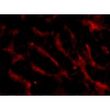TWEAKR (TNFRSF12A) Rabbit Polyclonal Antibody
Other products for "TNFRSF12A"
Specifications
| Product Data | |
| Applications | IF, IHC, WB |
| Recommended Dilution | WB: 2 - 4 ug/mL, ICC: 2.5 ug/mL, IF: 20 ug/mL |
| Reactivities | Human |
| Host | Rabbit |
| Isotype | IgG |
| Clonality | Polyclonal |
| Immunogen | Fn14 antibody was raised against a human IgG1 Fc-tagged Fn14 protein. |
| Formulation | PBS containing 0.02% sodium azide. |
| Concentration | 1ug/ul |
| Purification | Affinity chromatography purified via peptide column |
| Conjugation | Unconjugated |
| Storage | Store at -20°C as received. |
| Stability | Stable for 12 months from date of receipt. |
| Gene Name | tumor necrosis factor receptor superfamily member 12A |
| Database Link | |
| Background | TWEAK is a TNF family member produced by IFN-gamma-stimulated monocytes and induces multiple cell death pathways including caspase-dependent apoptosis and cathepsin B-dependent necrosis. These pathways are mediated by the binding of TWEAK by fibroblast growth factor 14 (Fn14), a member of the TNF receptor superfamily. Yeast two-hybrid experiments have shown that FN14 will bind to the TNFR-associated factors TRAF1, TRAF2, TRAF3, and TRAF5, suggesting that the signaling pathway induced by TWEAK may be mediated by one or more of these adaptor molecules. Fn14 is induced during liver regeneration and is highly expressed in hepatocellular carcinomas. In addition, TWEAK induces liver progenitor cell proliferation, suggesting Fn14 may play a role in hepatocyte growth control and liver neoplasia. |
| Synonyms | CD266; FN14; TWEAKR |
| Reference Data | |
| Protein Families | Druggable Genome, Transmembrane |
| Protein Pathways | Cytokine-cytokine receptor interaction |
Documents
| Product Manuals |
| FAQs |
{0} Product Review(s)
0 Product Review(s)
Submit review
Be the first one to submit a review
Product Citations
*Delivery time may vary from web posted schedule. Occasional delays may occur due to unforeseen
complexities in the preparation of your product. International customers may expect an additional 1-2 weeks
in shipping.






























































































































































































































































 Germany
Germany
 Japan
Japan
 United Kingdom
United Kingdom
 China
China





